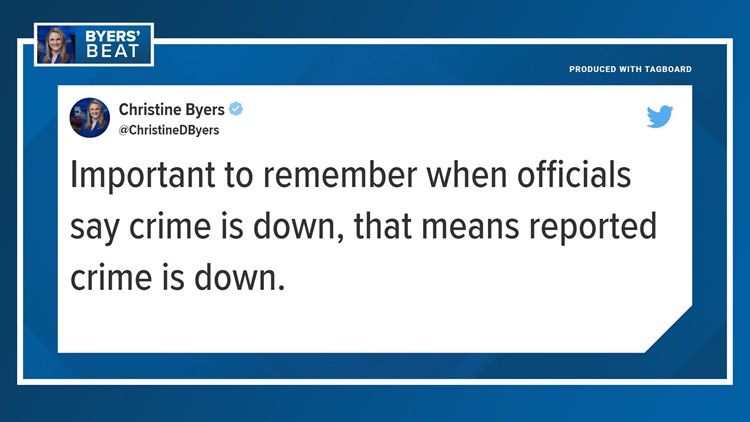ST. LOUIS — Important to remember when officials say crime is down, it means reported crime is down.
I tweeted those words earlier this week after hearing St. Louis Police Chief John Hayden talk about how the city’s crime rate is trending in the right direction. Homicides especially are down by about a third compared to the same time frame last year – which was the most violent year in the city’s history when it comes to homicides per capita.
Truth is, I’ve spoken those words and written those words countless times in my reporting through the years following incredibly insightful interviews with criminologists across the country – including one of the very best, Richard Rosenfeld of the University of Missouri-St. Louis.
Much to my surprise, the statement did not go over well with some folks on Twitter – including some academics and others I have followed through the years.
Suddenly, noting how we must be cognizant of how much crime goes unreported in our communities was somehow a fear mongering tactic on my part to help keep officers – and crime reporters – employed.
I actually called Rosenfeld to make sure there wasn’t some seismic shift in the research about unreported crimes that I was unaware of.
“For the somewhat less serious offenses like larceny, reporting is a significant issue,” he said. “For more serious offenses, reporting is less of an issue."
I followed up my statement on Twitter about crime stats with another tweet saying how homicides are the truest category of crime in the sense of accurate numbers – but even then, only homicides that fit the FBI’s definition of a homicide get counted.
Homicides deemed justified – including shootings involving police – do not get counted.
So far this year, there have been 24 such homicides -- none of them were officer-involved.
Compared to the same time frame last year, there were 17 -- three of them included officer-involved shootings.
So, on paper, the city has logged 130 homicides so far this year compared to 193 during the same time frame last year -- despite there being more violence than those numbers reflect.
In another twist, the FBI directs police departments to count homicides toward a yearly total regardless of when the victim suffers the injury that kills them. So, if someone gets shot in 2020, but doesn't die from those injuries until this year, their homicide will be counted within this year's total.
Still, it's one of the best categories to gauge a city's crime problem if you also look at it with aggravated assaults -- mostly those involving a gun.
Former St. Louis County Police Chief Jon Belmar once told me he actually used his aggravated assault category along with his homicide total to measure his crime problem because the difference between the two could be mere millimeters as well as the skill of the medical team.
“In the case of homicide, very few go undetected by the police,” Rosenfeld said. “There are relatively few justifiable homicides, at least as classified by the police, in any given year, so overall the homicide numbers remain pretty reliable.”
That means low level crimes, including property crimes, simple assaults, larcenies from cars, sexual assaults and incidents of domestic violence have the lowest levels of being reported to the police.
That’s because, sometimes, people just don’t want to get the police involved.
It could be because they don’t want their partner or spouse to go to jail.
It could be because they are ashamed of being sexually assaulted or don’t want to go through the pain of an exam and an investigation.
It could be because they are involved in a crime themselves when they become victimized.
It could be because they don’t trust the police.
It could be because they don’t think the police care about their communities.
It could be out of fear of retribution from their own communities.
You get the point.
And low-level crimes, especially larcenies from vehicles, make up a large portion of St. Louis’ crime rate.
In St. Louis, police leaders have a long and storied history with how they count crime.
And their counting method changed again at the start of this year.
My former colleague at the St. Louis Post-Dispatch Jeremy Kohler exposed how St. Louis police were writing memos instead of reports on certain rape cases in 2005. The series, titled, “What Rape?” explored how officers would write memos if they did not believe a rape had occurred instead of a report, which meant cases essentially didn’t get any further investigation. Then-Chief Joe Mokwa ordered the department to end the practice after the series ran.
A few years later, Kohler and I reported on how the department changed the way it counted vehicle break-ins during then-Chief Dan Isom’s leadership. He discovered the department was reporting vehicle break-ins as individual crimes. But the FBI’s crime counting policy called on departments to count car-break ins, or larcenies, as only one incident if it was reasonable to believe they all occurred during the same time, date and location.
In other words, a parking lot where 20 cars get broken into likely by the same people during the same attack should only count as one.
Top police leaders who survived the “What Rape?” scandal advised Isom to brief the public about why he was changing the counting method – saying the public perception lingering from the rape memo stories could come back to bite him even if his motives were pure.
He didn’t. We found out about it. We reported it. And it didn’t go over well with the public at the time.
Just this year, St. Louis police have changed the way they count crime again. This time, it is part of a national effort to transition police departments to a system known as National Incident Based Reporting System, or NIBRS.
It does away with the hierarchy of crime reporting in which only the most dangerous of offenses get counted.
Until now, if a person's car was damaged, they got robbed and assaulted only the assault would get counted.
Now, all three of those crimes will be counted.
And only if they’re reported.



